|
|   |

Customer Pricing Structure are Price Discounts or Markups which make up the pricing structure formats available in Autosoft 5. The Discount pricing will generally operate as a discount from your retail - or List Price. The Markup will operate as a mark-up from your Cost Price.
Header Area

Description - Select the matrix description by clicking on the ellipsis or type in a new matrix description name for a new Pricing Matrix.
Type - Discount - A Pricing structure type of Discount subtracts the percentage off the list price in the Stock Master File. The List Price is located under the Pricing tab as below.
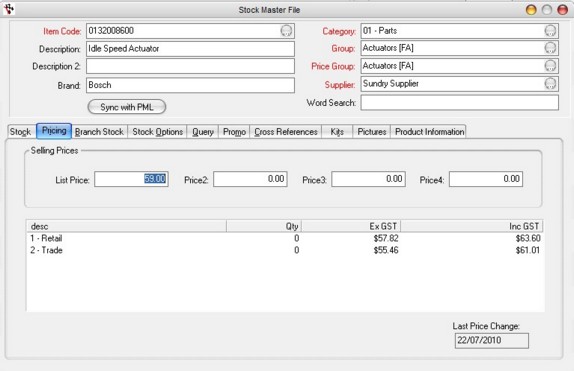
The List Price amount will be the exact price charged for a Pricing Structure that has 0 as the percentage for the Price Group Motors [EL], to which this product belongs. Any Discount applied will discounted from that List Price by the corresponding amount in the Price Structure setup.
In the Retail Price Structure, we have a 2% discount listed, so the Retail price will be 59 - (0.02 x 59) = $57.82. This is the price that you can see under the Ex GST column on the 1 - Retail price structure listed beneath the selling prices below.
Type - Markup - Markups are created by increasing the Average Cost, Current Cost or Last Cost in the Stock Master File by the percentage listed in the Pricing Structure setup.

Additionally, if you want the mark-up to be based on the highest of those three distinct costs, this can be done as well. To set the preference for the Mark-up, you will need to alter your settings in the System File to represent the cost that you want to use as the basis of your mark-up. Navigate to Utilities > System Set-up > System File and look at the Parts Tab > Parts Options 2 Sub-Tab. There you will find the Markup Type as shown below.
Remember to restart Autosoft after any changes to this option on all computers to make the changes active.

NOTE: The only one of these costs that can be manually adjusted in the Stock Master File is the Current Cost. Average Cost will be your average over time from ALL creditor invoices, and Last cost will be the cost on your LAST creditor invoice only.
For the product listed above, the Average Cost = $47, Last Cost = $47 and Current Cost = $45. Using Highest Cost as your Markup Type will result in the $47 price being used, as it is the highest amount that appears in any of these three cost fields. Hence all markup price structures will begin at $47 and apply their percentages based on that $47 amount (ie 10% mark-up will result in a Item price of $47 + $4.70 = $51.70). GST is then applied to the newly adjusted price on the customer's invoice.
Show in Price Enquiry - Tick this box to enable the matrix price to show in the Price Enquiry screen and also the Stock Master File under the Pricing Tab.
Stock Master File - Pricing Tab

Price Enquiry

Branch Number - The branch number for those system with multiple branches.
Price Structure Tab
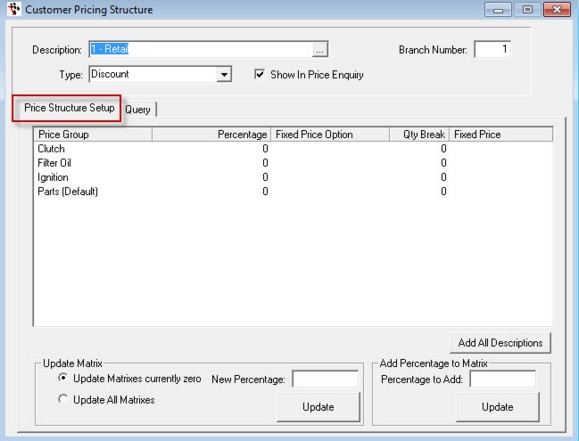
Columns in Grid:
Price Group - The Price Group column has the relevant Price Group. Every stock item in the Stock MAster File must belong to a price group.
Percentage - The percentage mark-up or discount that will be applied to all products in that Price Group. Changes to these percentages can be made directly in the grid.
Fixed Price Option - Click in the column next to the corresponding Price Group and click the Down-arrow - a list of Fixed Price options will appear as below
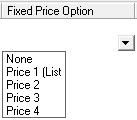
These include None, Price 1 (List Price), Price 2, Price 3, Price 4, Price 5, Price 6 and Price 7. These correlate directly with the Stock Master File, under the Pricing Tab. This allows you to set up to 7 distinct fixed prices to charge for the item.

Qty Break - The Quantity break allows for different percentage changes based upon quantity sold. Below, for the price group Actuators [FA], There is a 1% discount when Quantity is 0-4, 2% discount when it is 5-9, 4% when it is 10-19 and 8% when it is 20+. There is also a 10% reduction in the case of 50+ being bought

Going back to the Stock Master File of into the price enquiry reveals the new prices listed as multiple entries against the '1 - Retail' Price Matrix
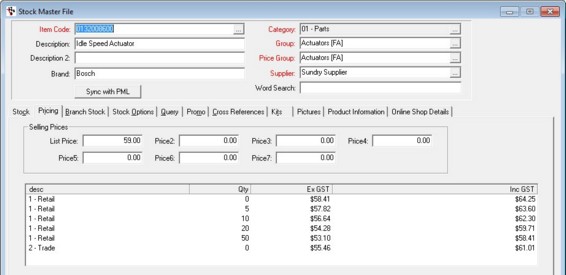
Stock Master File

Price Enquiry
Buttons

Add All Descriptions - Click this button to add all Price Groups to the Price Structure grid. You are then able to type in the discount or markup percentage corresponding to the Price Group. Adds all Price Groups (Matrix Descriptions) setup in the Price Groups to the Pricing Matrix.
Edit - Highlight the matrix description you want to edit and click this button to edit an individual matrix description to the matrix. Make the changes and click on the Save button.
Delete - Highlight the matrix description you want to delete and click this button. Click Yes to confirm the deletion.
Update Matrix
This is used to enable you to quickly update the Pricing Group entries with a new percentage.

New Percentage - type in new percentage and choose either:
Update Matrixes Currently Zero - will only update price groups with 0 in the percentage column to the new value
Update All Matrixes - updates all price groups irrespective of their current percentage to the new value.
Update - click this after all information on the update matrix were filled up.
Add Percentage to Matrix
Will add a percentage to the Price Group's existing percentage.

Percentage to Add - Enter the amount to augment the amount by.
Update - click this to apply the change.
Markup Selling Price from Creditor Invoice
Cost Price can be marked up from the Creditor Invoice to arrive at the Selling Price in the Stock Master File by using the Retail Markup matrix.
In the Pricing Matrix program add markup percentages to the Retail Markup matrix, these will be used for creditor invoice pricing.
When processing a creditor invoice tick the box in the Options button ![]() "Use Retail Markup to Calculate Selling Price Changes". What this will do is markup each stock item by the Retail Markup matrix percentage and enter that price in the Selling Price field in the Stock Master File.
"Use Retail Markup to Calculate Selling Price Changes". What this will do is markup each stock item by the Retail Markup matrix percentage and enter that price in the Selling Price field in the Stock Master File.
Note: Selling and Cost prices do not include GST.
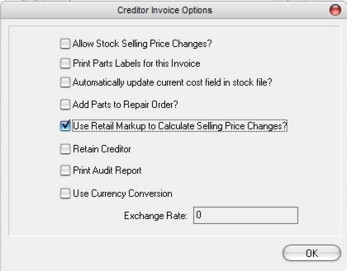
Query Tab

There are a couple of useful queries in the Query tab.
Customers using Selected Price Structure
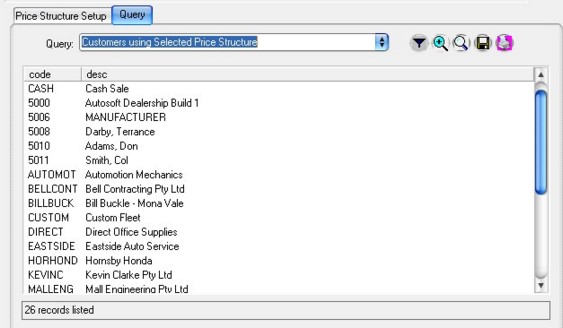
Customers with more than one price structure

The second query is for customers set up with Multiple Matrixes in the Debtor Master File.
Management and creation of Pricing Structures
The creation and maintenance of these pricing structures are done through four separate areas of the software:
NOTE: In previous versions of Autosoft the Price Structure was referred to as the Price Matrix, and a Price Group was known as a Matrix Description, so if you are familiar with these terms from Autosoft 5 or earlier, it is effectively the same definition for both of these terms.
Stock Master File:
In the Stock Master File, each item must have a Price Group entered into the Price Group field. These Price Groups are setup in the Price Groups menu option, and are selectable by hitting the ellipsis ![]() in this field.
in this field.
Is is important to note that Price Groups need to exist in order for a Pricing structure to be created.

Debtor Master File:
In the Debtor Master File click on the Options tab, and the Options Sub-Tab, and select the Price Structure. The pricing for each debtor is set individually via this field. Multiple debtors can belong to the same pricing structure, or in theory each debtor could have a separate pricing structure (although this is unlikely). The example below shows a typical setup with a Retail and Trade pricing structures, and has a couple extra in Warranty and Internal. The Automation Mechanics entry is a customer-specific Price Structure.
As more pricing structures are created, this list will grow. Each business can regulate and maintain their own quota of price structures - although having too many price structures can potentially be counter-productive.

Each Price Structure functions as a markup or discount mechanism - however in the Debtor Master file the function of the price structure is not apparent. For this you will need to look at the Customer Pricing structure option in the Parts menu.
Customer Pricing Structure:
This is where the individual price structures are configured, essentially telling the system what to charge a debtor for distinct Price Groups based on the specific price structure chosen.

Hitting the ellipsis ![]() will bring up the available descriptions for price structures, and in this selection screen the nature of the price structure will be shown as well - whether it is a Markup (M) or a Discount (D).
will bring up the available descriptions for price structures, and in this selection screen the nature of the price structure will be shown as well - whether it is a Markup (M) or a Discount (D).

The Matrix Descriptions are setup by adding a description that you can then allocate a matrix percentage to in the Price Matrix.
To create a new Pricing Structure, type in the Description and select the Type (Discount or Markup) then hit F2 to save. You can tick the Show in Price Enquiry box and enter a Branch Number too where applicable (function of these are explained shortly).

Once you have hit F2 the description will clear, but when you click on the description ellipsis again to search for existing Pricing Structures, your new addition will be there.
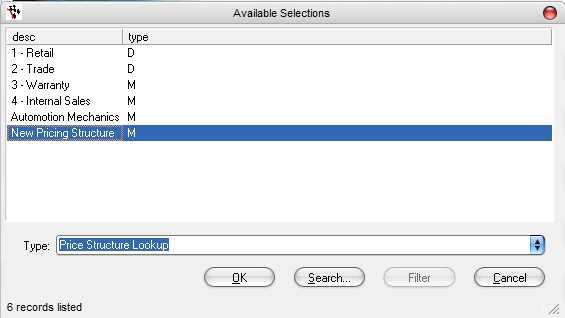
Basic Pricing Structure:
Select your new pricing structure, and you can then begin to build the conditions into it that will determine pricing for debtors who are allocated to this.
The first thing to do is to bring in the various price groups which you can do by hitting the ![]() button. This automatically pulls EVERY price Group from the Price Groups menu option and lists them in the Price Structure Setup Tab, as below.
button. This automatically pulls EVERY price Group from the Price Groups menu option and lists them in the Price Structure Setup Tab, as below.
Price Groups can be deleted and added from the list (Shift + F2 to delete or click the ![]() symbol on the toolbar when the relevant row is highlighted)
symbol on the toolbar when the relevant row is highlighted)

Now you have the option of individually configuring each Price Group by clicking on it in the list. Click in the Percentage column and you can manually enter in a number to correspond to the percentage change you want to apply to any product assigned to that price group.
The Bearings Price Group has been altered below to 10 (representing 10%) hence the price of any item that belongs to that Price Group in the Stock Master File will be 10% markup from cost for any Debtor assigned to that Pricing Structure in the Debtor Master File.
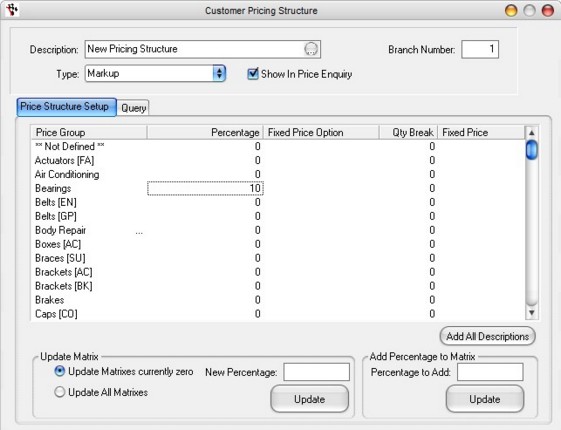
You can repeat this process for every Price Group you have in your system if you want. This is a fairly cumbersome and time-consuming way to set this up however. There is a faster way to set percentages for all available price groups, via the Update Matrix and Add Percentage to Matrix options beneath the Price Group list.


These allow for changes to the percentages to be applied to an entire list in a variety of ways:
- Update Matrixes Currently Zero:
This will update all Price Groups with a percentage set to 0 to update to the New Percentage. typing 10 into that field and hitting the ![]() button will affect all Price Groups, except for the Bearings Price Group changed just before. You will be prompted to go ahead with the changes to the matrix as per below.
button will affect all Price Groups, except for the Bearings Price Group changed just before. You will be prompted to go ahead with the changes to the matrix as per below.

Hit ![]() to apply the changes and the list will update to the below:
to apply the changes and the list will update to the below:

This is the most basic form of percentage change that can be applied to a product based upon the pricing structure.
Complex Pricing structure:
To add more complex conditions to a Pricing structure, you can edit each percentage maunally to create a more comprehensive list of percentage mark-ups / discounts.

The example above will mark-up the cost price by the corresponding percentage listed in the Percentage column, and that will be the price that appears on an invoice for a debtor assigned to that Price group.
Modifying a Price Structure:
All percentages for a particular Price Structure can be amended by using the Update Matrix and Add Percentage to Matrix options beneath the Price Group List.


The Update Matrixes currently zero procedure was shown above, and this option amended ALL entries that had a value of zero to the New Percentage listed (which was 10). The alternative is Update All Matrixes. This will change every Price Group to the percentage you type into the New Percentage field when you hit the ![]() button, irrespective of their current value.
button, irrespective of their current value.
To incrementally increase or decrease a percentage use the Add percentage to Matrix option. Type your amount in the Percentage to Add field, and hit ![]() . To add 5 percent, type 5 in the Percentage to Add field and update. To reduce the percentage by 5%, type -5 in the Percentage to Add field and update. These options make changes to all the listed Price Groups, so only use this when making wholesale changes to the way a specific Price structure works.
. To add 5 percent, type 5 in the Percentage to Add field and update. To reduce the percentage by 5%, type -5 in the Percentage to Add field and update. These options make changes to all the listed Price Groups, so only use this when making wholesale changes to the way a specific Price structure works.
Individual Price Group changes must be done manually.
Using Quantity Breaks
The Quantity break allows for different percentage changes based upon quantity sold. Below, for the price group Actuators [FA], There is a 1% discount when Quantity is 0-4, 2% discount when it is 5-9, 4% when it is 10-19 and 8% when it is 20+.

You need to have a Quantity Break greater than Zero entered next to a Price Group to be able to add it more than once to a Pricing Structure.
Using Fixed Pricing:
Click in the Fixed Price Option column next to the corresponding Price Group and click the Down-arrow - a list of Fixed Price options will appear as below. At this stage, the Fixed Price Option and Fixed Price columns are the same.

These include None, Price 1 (List Price), Price 2, Price 3, Price 4. These correlate directly with the Stock Master File, under the Pricing Tab. This allows you to set 4 distinct fixed prices to charge for the item.

These prices would need to be set for every product in the Price Group for this pricing mechanism to operate properly.
|
What are you trying to do? |
Video/Knowledge base Guide |
|
Setup general Workshop Saletype Pricing for customer types |
|
|
Setup Price Groups and for customers with differing pricing dependant on Price Groups |
|
|
Setup Promotions for Specials and Catalogue Prices |
|
|
Learning how to do a price increase. |
http://service.autosoft.com.au/entries/21274418-How-to-do-a-Price-Increase |
|
How to set automatic pricing on your stock relative to criteria |